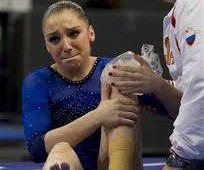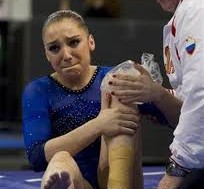More About ACL Injuries
Author: admin

Recently, a reader, “AR”, sent me the following comments in response to my article “The ABC’s of ACL Injuries in Gymnastics”.
These were thoughtful questions, and because the answers may be helpful to other readers, I am sharing the questions and answers in this follow-up article.
I appreciate questions as an opportunity to share healthful and healing information.
 Here is what the reader wrote:
Here is what the reader wrote:
“I admire and appreciate your work, Gina; I have a few questions regarding this article.
You mentioned several times that the MOI for ACL tear in gymnasts is hyperextension. Is hyperextension more associated with ACL or PCL tears in this population?
Secondly, you mentioned a recovery window of 4-6 months. Is there a specific return to sport criteria are you using? To safely return to an elite level sport I rarely see an athlete fully return in less than 9-12 months, no matter how great the rehabilitation.
In your professional opinion, do you think there will be long-term consequences for those young gymnasts who resume the sport too early?”
And here are my answers:
The ACL prevents the shin bone from translating forward on the thigh bone, and it helps the knee from “Twisting” in ways that it should not. There is a small amount of rotation that the knee joint needs to allow, but any more than that allowable amount usually results in injury/tears.
ACL’s can be torn in many ways. The most common ways are hyperextension with or without rotation, and change of direction while foot is planted resulting in large amounts of rotation (in gymnastics world this means land with foot planted while body still is rotating as an example).Most (greater than 75%) of ACL tears are non- collision, but may be from impact with objects (ground, dashboards, etc.). Most are done in single or double leg weight bearing position.
To clear up the concern on hyperextension, technically (anatomy- related) hyperextension involves the shin bone (tibia) moving forward on the femur. So, this mechanism would result in an ACL tear, because the ACL is what is supposed to limit this. However, if the hyperextension occurs where the force is above or superior to the knee joint itself, resulting in the femur moving forward on the tibia (or if the stress is below the knee joint and the tibia is forces backwards or posterior) then the PCL is effected.
In regards to recovery time, that is a general statement. There is no way to tell how someone will recover, and what you consider “Recovered”. Some people think that getting back to walking and Activities of Daily Living is recovered, in the general population. A basketball player will have different recovery time than a gymnast, depending on sports demands. So, in the general literature, there is just a guideline that is stated. Full recovery would be that the athlete is back to pre-injury conditions- meaning:
- Jump height- tested bilateral and unilateral, to max heights
- Jump height even left and right (injured and uninjured)
- Agility testing
- Ground time in jump tested
- Run speed
- Quad strength
- Hamstring strength
- Glute strength
- Quad to hamstring ratio
- Physical anatomy (scar tissue within and between muscles gone!)
- Flexibility back to pre-injury conditions
- Subjective answers to questions on confidence in the leg
- Fatigue in three ways: within conditioning sets, within practice, within microcycle (could be week or month) and within a macrocycle (longer period of time)
- Compensations being gone, examples are in the low back, ankles, and hip
Typically, gymnasts recover both faster and slower than others… let me explain. Faster- because they are stronger to begin with and have very little down time! Slower- because the sport is so demanding (depending on the level that you are returning to) and your strength, as well as landing surfaces, struggle with body weight if you are sedentary during rehab, etc. As for the Elite level, as you mentioned, I too, believe that it takes longer- sometimes up to a year and even more. The article was not written for Elites, but to encompass all levels, which is hard to do! If you ask any high level athlete about their ACL tear, they will rarely say it is never on their mind, or that they are “Recovered”. Some of this is because it is as much of a game of mental toughness when doing gymnastics as it is physical. Other aspects are because you are constantly fighting favoring, trusting, etc the knee. Before it was injured, you never thought about it. Then, after the tear, it is always on your mind.
Finally- let’s address your concerns of returning to sport too early.
In general here are the risks of returning to sport too early:
- If you are not strong enough to handle your body weight or the demands of the sport + gravity + speed, then reinjury may occur. Reconstruction, the second time around is much harder. Depending on the method of repair the first time, you may have to seek alternatives (patellar tendon graft and hamstring graft may not be available if you already used them, need to use the other side which complicated rehab, or use a cadaver graft as some options).
- Other injuries may occur, such as meniscus tears, muscle strains, etc, because of lack of strength
- Other injuries may occur because of lack of stability and return of balance and proprioception (knowing where your body is within space!)- such as ankle sprains, ligament tears, hip pain, etc.
- Compensation with the other leg being stronger is an issue. Gait deviation issues include hip pain, SI joint pain, low back irritation, injury to the other knee, injury to the other ankle, and more.
- Strained muscles. This can happen when you are trying to muscle through a skill at maximum force output if you are not strong enough yet… so, if when you are doing a split leap, you use 40% of your available power to jump, but now you need to use 98% of your available power, muscle is going to get “mad”, strain, tear, etc.
- In general, if the ACL is not healed, is stretched, is no functioning properly, or is disallowing proper mechanics of the knee, many studies have shown (in humans, dogs, and more) the increased risk for arthritis, which happens when padding (meniscus, cartilage, etc) is injured or diminished and/or when the arthokinematics (motion) of the knee is not as it is intended!
Thanks for your concern, and I hope that clears up all of the questions that you have!
Gina
P.S. If you have questions about any of my articles, please post them in the Comments section below the article, with your name and e-mail, and I’ll get back to you.
